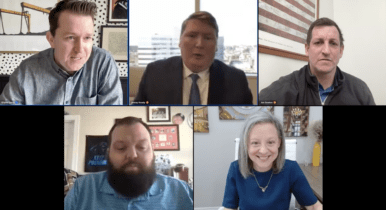For too long, landline phones have been the gold standard for telephone contacts due to the fact that we could use a predictive dialer and plow through a list four or five times in a day. Cell phones, with their pesky FCC restriction requiring hand dialing, were always more expensive.
It was typically assumed that if someone has both a landline and a mobile phone, then we were fine to just dial the landline. Those days are over.
Mobile phone usage as the “home” phone has grown to numbers we’ve never seen before. Take the state of Arizona, for example, where more than 3.4 million household phone numbers exist and of those, 2.5 million list a household phone as a mobile phone. The game has shifted to mobile contacts and for telephone voter contact, it’s evolve or die.
Even though telephone voter contact thrives on not being face-to-face, it’s still impacted by the ongoing Covid-19 pandemic. Like a lot of other businesses, most commercial call centers had to move to remote working just to stay open. The telephone service representatives weren’t able to sit next to each other in a closed environment while talking into a headset all day.
That would have been more of a super spreader event than anything we saw during the final months of the Trump administration. To maintain their work, representatives took their equipment home and, just like the volunteer predictive dialing, they connected remotely. Hand dialing is time consuming, but when forced to learn how to speed up the process or not have any work, guess what: hand dialing became a lot faster and a lot more efficient.
Contact rates are way up, too. The days of the “sweet spot” being dials between 6-9 p.m. are over. I’ll bet that right now your mobile phone is within reach, and if it rang with an actual number and a caller ID that wasn’t “call center” or “unidentified,” chances are you’d pick it up. For example, we did a program throughout the state of New York recently and 63 percent of our list answered for an ID call. This number is up from 55 percent just two years ago when we were also targeting landlines.
This is the new reality for political telephone voter contact. We can target the mobile phone numbers without increasing the price per contact. In addition, daytime calling gives us more flexibility to reach people in a shorter time frame as opposed to trying to cram the program in to three hours over two nights.
So, to wrap up, we’ve discussed how this old-school medium is once again sexy in terms of a tactical deployment for a campaign. Okay, maybe that’s a bit too far, but bear with me.
When you’re ready, here are four questions you should be asking your telephone voter contact partner and your campaign: 1) Am I targeting the “home” phone regardless of whether that phone number is a landline or a mobile? 2) Do I care at what time during the day/night the calls are actually dialed? Hint, you do not. 3) Have I adjusted my script knowing that I may catch someone off-guard and have I added a disposition to call back at a later time, as opposed to a disposition that removes the number from the overall program due to a non-answer response? 4) Is the call center I’m working with hand dialing and not using preview mode? Remember, all 10 numbers must be entered and initiated to ensure FCC compliance.
In such a competitive midterm cycle, telephone voter contact programs for identification, persuasion, and GOTV can’t be stuck in the tactics from 2008. It’s time to adjust practices to reach voters more effectively because what worked then, won’t work for us now. As I said, right now, it’s evolve or die.
Ryan Hawkins is President of 1880 Strategies and former President of the Winding Creek Group, both telephone voter contact firms that have worked with Democratic candidates and Progressive causes since 2007. Originally from Oklahoma with a stopover in Washington, DC as part of the DCCC, Ryan now resides in St. Louis, MO with his 15-year-old daughter, his dog and is living as one of the lone Dodger fans in a sea of Cardinals.



